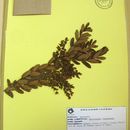Description
(
Inglês
)
fornecido por AmphibiaWeb articles
Female: 29-32 mm, Male: 22-25 mm. Dorsum greyish dark brown with many small ocher or yellowish spots. The belly and chest are orange, with irregular dark blotches. As all the species in the M. tumifrons group, this toad has a conspicuous frontal swelling.
- Prigioni, C. M., and Langone, J. A. (1986). ''Melanophryniscus orejasmirandi n. sp. un nuevo Bufonidae (Amphibia, Anura) de Uruguay, con una clave para las especies del grupo tumifrons.'' Comunicaciones Zoologicas del Museo de Historia Natural de Montevideo, 159, 1-11.
- Prigioni, C. M., and Langone, J. A. (1990). ''Descripción de la larva de Melanophryniscus orejasmirandi Prigioni & Langone 1986 (Amphibia, Anura, Bufonidae).'' Comunicaciones Zoologicas del Museo de Historia Natural de Montevideo, 173, 1-9.
Distribution and Habitat
(
Inglês
)
fornecido por AmphibiaWeb articles
This species is only know from a few localities in southern Uruguay. The habitat is at the top of hills, in rocky soils.
Life History, Abundance, Activity, and Special Behaviors
(
Inglês
)
fornecido por AmphibiaWeb articles
Little is know about the natural history of this species. Females with mature eggs were found during cold months (May to August). These toads seem to be explosive breeders with diurnal activity after heavy rains. This species exhibits the typical defensive behavior of the genus "Unkenreflex".
Life History, Abundance, Activity, and Special Behaviors
(
Inglês
)
fornecido por AmphibiaWeb articles
The populations of M. orejasmirandai could be threatened by consequence of habitat loss.
Brief Summary
(
Inglês
)
fornecido por IABIN
Diagnosis A large species of the Melanophryniscus tumifrons species group (snout-vent length = 18.3?35.6 mm; mean = 26.4 ± 3.6 mm; n = 25) differs from other species of the group by the following combination of characters: (1) presence of small tubercles on dorsum and venter; (2) frontal tumefaction extending from between the eyes to near half length of upper eyelids; (3) tumefaction unique, with conic granulations and a light central longitudinal sulcus; (4) in life, ventral color pattern of reticulated orange, vestigial black reticulated spot on gular region, and large trapezoidal red spot on femoral region.
- licença
- cc-by-nc-sa-3.0
- direitos autorais
- Museo Nacional de Historia Natural
- autor
- Esteban O. Lavilla
- editor
- Diego Arrieta
Distribution
(
Inglês
)
fornecido por IABIN
Present in the municipalities of São Lourenço do Sul (type locality), Porto Alegre, São Jerônimo, Dom Feliciano, and Caçapava do Sul, State of Rio Grande do Sul, Brazil, and Cuchilla de Mangrullo, Department of Cerro Largo, Uruguay.
- licença
- cc-by-nc-sa-3.0
- direitos autorais
- Museo Nacional de Historia Natural
- autor
- Esteban O. Lavilla
- editor
- Diego Arrieta
Diagnostic Description
(
Inglês
)
fornecido por IABIN
Description of lectotype General aspect robust, bufonoid. Head broader than long; head width nearly one third of snout-vent length; head lacking cranial crests; snout short, projecting slightly beyond anterior margin of mouth, rounded in dorsal view and vertical in lateral view; a prominent, rounded protuberance on dorsal aspect of snout, extending between the eyes to a point near the mid length of upper eyelid; in lateral view, snout protuberance is raised above the level of upper eyelid; an inconspicuous longitudinal sulcus bisects the snout protuberance; canthus rostralis rounded due to snout protuberance; loreal region slightly concave, vertical; nostrils very small, at tip of snout, directed anteriorly; internarinal distance nearly equals upper eyelid width and approximately half of interorbital distance; interorbital distance nearly twice upper eyelid width; eye diameter larger than internarinal distance, eye to nostril distance, and upper eyelid width, and about 75% interoribital distance; tympanum concealed; vocal slits present; tongue rounded, much longer than wide, with posterior margin free; choanae small, rounded, largely separated. Arms slender, lacking ulnar folds; axillary membrane absent. Hands currently damaged, with fingers short; length of fingers from shortest to largest, II
- licença
- cc-by-nc-sa-3.0
- direitos autorais
- Museo Nacional de Historia Natural
- autor
- Esteban O. Lavilla
- editor
- Diego Arrieta
Conservation Status
(
Inglês
)
fornecido por IABIN
DD. Data Deficient.
- licença
- cc-by-nc-sa-3.0
- direitos autorais
- Museo Nacional de Historia Natural
- autor
- Esteban O. Lavilla
- editor
- Diego Arrieta
Melanophryniscus pachyrhynus
(
Inglês
)
fornecido por wikipedia EN
- licença
- cc-by-sa-3.0
- direitos autorais
- Wikipedia authors and editors
Melanophryniscus pachyrhynus: Brief Summary
(
Inglês
)
fornecido por wikipedia EN
Melanophryniscus pachyrhynus is a species of toad in the family Bufonidae. It is known from São Lourenço do Sul in southern Brazil and from Uruguay. Populations in Uruguay were until recently considered a different species (Melanophryniscus orejasmirandai) and assessed as being vulnerable.
Its natural habitats are subtropical or tropical seasonally wet or flooded lowland grassland, intermittent freshwater lakes, and intermittent freshwater marshes. It is threatened by habitat loss.
- licença
- cc-by-sa-3.0
- direitos autorais
- Wikipedia authors and editors

